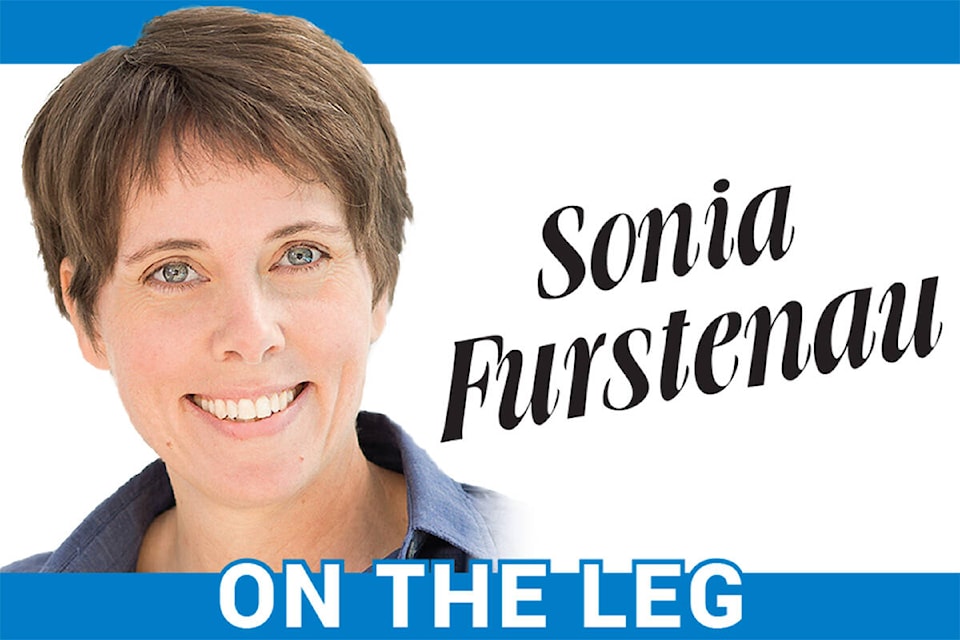By Sonia Furstenau
If you are, or have ever been, a driver, you probably remember that exhilarating moment of getting your licence. You might feel nostalgic about the sense of freedom you gained — driving on the open road you are imbued with a feeling of endless possibility. The freedom of going anywhere you want, whenever you want, is a beautiful thing. What if you experienced those same feelings of freedom while riding public transportation?
On Thursday morning last week, I commuted to the Legislature from Shawnigan Lake using public transit. It was a relaxing and pleasant way to travel, but the service as it stands is challenging. There are only two buses in the morning — one leaves Shawnigan village shortly after 6 a.m., and the other shortly after 7 a.m. The return buses leave downtown at 3:40 or 4:40. The cost each way? Ten dollars — significantly more than the cost of catching the bus from Sooke to Victoria. Rather than making it easy for me to use transit to go from Cowichan to Victoria, the system itself presents multiple barriers. There were about 10 of us on the bus that morning — a very comfortable bus, and I was grateful for the expert driver navigating the wet roads and heavy traffic while I was able to catch up on emails and text messages.
I also thought about what a robust public transportation network might look like in our province. A reduction of vehicles on the road would lead to fewer emissions, cleaner air, and people getting to where they need to be safely and quickly.
One of the goals of the Clean BC Roadmap to 2030 is reducing the number of private vehicles on the roads by 25 per cent across the province. With frequent and reliable public transit, it can be easy to conceptualize a car-less (or less-car) future in metropolitan areas like Vancouver. But due to a lack of imagination and investment from government, it is difficult to visualize this car-less future in rural and remote areas of B.C. Moving forward, investing in a vision for rural transit in our province will be critical to achieving a cleaner, safer, and healthier British Columbia.
In many communities on Vancouver Island, getting to healthcare appointments, visiting family, and commuting to work are otherwise impossible tasks without a private vehicle. Improving intercity public transit on our island would lead to a multitude of environmental, social, and economic benefits, but the political will to make the changes needed is sorely lacking.
A reality we must confront is that public transportation is a public service, and it should be treated as such. Public transit, particularly in rural areas, isn’t about making money, it is about public safety, equity, and accessibility.
Kukpi7 Judy Wilson, Union of BC Indian Chiefs, explains the correlation between MMIWG, climate change, and transportation. Areas with poor or non-existent public transit have higher rates of Missing and Murdered Indigenous Women and Girls (MMIWG). With gaps in transportation, especially between cities, hitchhiking is left as one of the only options for inter-community travel, an option that exposes vulnerable people to tremendous risk.
For many people with disabilities or mobility challenges, seniors, young people, and low-income individuals, driving often isn’t an option. Accessible, affordable, and reliable public transportation is essential to delivering equity and safety. We shouldn’t be creating a society where there is an expectation that if you don’t have a car, you can’t travel. I want to envision a future where everyone, regardless of age, ability, or income level, can travel freely within and between communities.
With the suspension of yet another bus route, nearly two dozen communities on Vancouver Island will be without safe and reliable intercity transportation. Wilson Transportation, the company operating the intercity bus routes between Nanaimo and Tofino, and Nanaimo and Campbell River, announced that they would be halting these routes until May. The company explained that ridership along these routes decreased significantly throughout the pandemic, and acutely so during the winter months. They explained that with so few ticket sales, and no continuous funding from the province, that it would no longer be affordable or viable to continue these services.
In response to the suspension of Wilson Transportation’s intercity routes on Vancouver Island, Islandlink has stepped in to fill the service gaps by introducing a Nanaimo-Tofino route three times per week. Although this will ensure greater safety for individuals travelling between these communities, this situation is a sore reminder that the government needs to be doing more.
Our provincial agency, BC Transit, needs to be oriented to the needs of the people to create robust and reliable transit corridors. Regional districts and municipalities can work to create localized transit routes that serve to connect individuals to these corridors.
Public transit needs to be affordable, reliable, and safe. Without these core tenets, public transportation will be unusable and therefore not serving anyone. As individuals, we need to reorient the mindset of the society we want to live in. We need to prioritize equitable access to public services, like public transit, without prescribing a price tag to our safety and wellbeing.
We want to hear from you, and what your vision is for transit in Cowichan and beyond. Please reach out and share your thoughts with our office at sonia.furstenau.mla@leg.bc.ca and put “vision for transit” in the subject line.
Sonia Furstenau is the MLA for the Cowichan Valley and leader of the BC Green Party.
